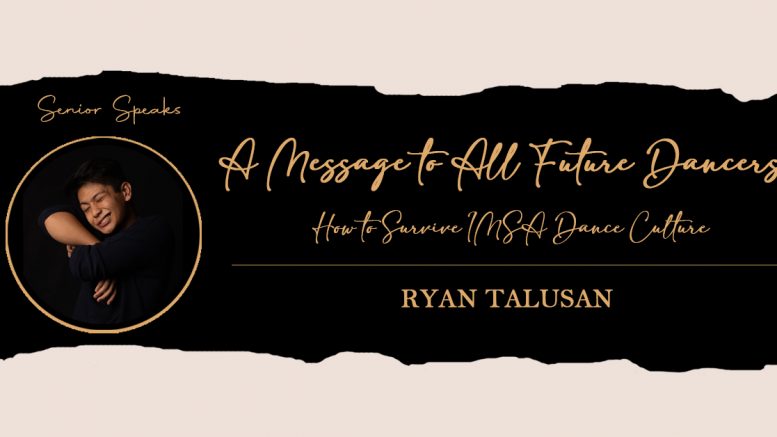One of the sections included in the annual Senior Edition is a series of essays titled Seniors Speak. These works are written and submitted to The Acronym by members of the graduating class, allowing them to reflect on their experiences, share advice, and advocate for change. The writer of this piece is Ryan Talusan (UIUC ’24), who lived in 1504D wing all three years. While at IMSA, he was a choreographer/dancer for many events, involved in ASIA, and played basketball and volleyball.
Coming into IMSA, I was blessed with a God-given gift: the ability to body roll. I didn’t think much of it because I never thought anyone would care, but as soon as my wingmates discovered my hidden talent, they pressured me to become a sophomore choreographer for Homecoming Drill. Reluctantly, I agreed, and I had no idea what I got myself into. This was the start of my dancing journey at IMSA, and although I never got the chance to attend that pep rally, I did get to see a few things after 10 check: the smiles on everyone’s faces, the congratulatory hugs, and the joy that dancing brought to my exhausted upperclassmen. A special type of love was in the air – the kind that only IMSA people can understand. Our dance culture is not the only thing that brings the IMSA love out of people, but you can see it in almost every photo taken at our culture shows and pep rallies. So, here is a guide on how to enjoy IMSA’s dance culture to the fullest.
For Participants:
1. JOIN! JOIN! JOIN!
During my time at IMSA, I’ve heard countless people say that they don’t want to join a dance because “they don’t know how to dance” or “they don’t want to make the dance look bad.” To these excuses, I would always respond with, “Don’t worry about how you look, it will be fun!!” Choreographers will always make choreography that they know everyone can do, and they will always find time to work with you individually as long as you are willing to put in the effort as well. It will all be worth it in the end when you get to show off your hard work to everyone.
2. Be Patient and Respectful
Choreographers put in so much time to create a dance that they feel would be fun for everyone. If you ever walk into the student union after school, chances are you will find one of your classmates choreographing a song or making formations for an upcoming culture show. However, choreographers aren’t perfect. They will forget choreography when they are teaching, they will forget to put your name into a formation, they will be disappointed when a move doesn’t hit as hard as they wanted it to, and they most definitely will be stressed weeks before the show. The best thing a participant can do is be understanding of a choreographer’s mistakes, trust that they will figure it out eventually, and be prepared to put in work when they are finally ready. Also, do not badmouth other choreographers, and if there are conflicts regarding scheduling or practice spaces, let the choreographers of each dance handle it. Toxic people make the dance harder for participants to enjoy, so please be patient and respectful to each other.
3. Happy E M O T I O N
Be happy, smile your biggest smile, and vibe with the songs that you are dancing to. Dancing at IMSA is not about showing off, and it is not about being better than others. The main reason anyone at IMSA should dance is to take a break from stressful homework to make memories with their friends. Whether it be singing “Let it Go” with your hall or hyping up your friends as they perform cultural dances, these moments are ones that are exclusive to IMSA students. Remember that rush of happiness and relief you get after performing, and never forget the countless hours you spent to perfect a dance. Please enjoy the dancing culture as much as possible because I can bet that you will never get to perform in front of a community as close-knit as IMSA’s.
For Choreographers:
1. For Drills: Find a Balance of Competitiveness and Fun Times
I know you guys love to compete, but winning isn’t everything. Your jobs are to make sure your participants are enjoying themselves while also encouraging them to get better. You have to fuel your hall’s fire. For example, if your hall or your class has given up or accepted defeat, then you shouldn’t continue pushing them to victory; instead, you should push them to have fun. Whether it involves changing your choreography to be more enjoyable or altering your attitude and teaching style to make them want to come to practice, you have to adjust to the desires of your participants. If your hall or class knows they are capable of winning, then push them towards that direction. Choreographers have the responsibility of keeping their people hyped and excited for the final performance, so as long as you choreograph for them and not yourself, you will eventually find that balance.
Pro tip: I think the best way to always keep your dancers engaged is by having at least one really dinky song that everyone will love.
2. For Culture Shows: Believe in Yourself and Believe in Your Dancers
The biggest key to choreographing culture shows is believing that everyone will pull through and make it work somehow. During each of the culture shows, there are always so many things going on, and you can’t expect everyone to come to every practice even if you say it’s mandatory. IMSA people have a natural talent at procrastinating, and if you have ever been one of my dancers, you would know that I procrastinate to the point where I have to create choreography on the spot. In the same way, your participants will always find a way to figure it out, and they will be ready for the performance.
Pro tip: Bring food to practices to make people want to go. Examples of good snacks are fruit jellies, fruit from Sodexo, granola bars, cookies, and cultural snacks. Cultural snacks are the best because you can teach people about your culture in more than one way.
3. Make Them Smile
The most important thing is to make them smile. Basically, if your dancers aren’t smiling, then you are doing it WRONG. If people complain about your dance, then listen to them. No one joins a dance at IMSA for pain and suffering, so you have to find ways to make dancing enjoyable. Some ways to ensure that your group is satisfied is to play fun songs when they are taking water breaks, cancel practices when they look drained, be understanding of their situations, and give them food incentives for coming. Choreographing at IMSA is not about earning clout as a dancer or proving to people that you are good at dancing. Being a choreographer means that people are trusting you with their happiness, so you should do anything in your power to see your dancers smile.
One Last Thing:
On your way out of the main building from a 9-10 practice, take a moment to breathe the fresh air, look up at the stars that twinkle on clear nights, and appreciate how crazy IMSA love is because you will never experience anything like it.






Be the first to comment on "Seniors Speak: A Message to All Future Dancers: How to Survive IMSA Dance Culture"